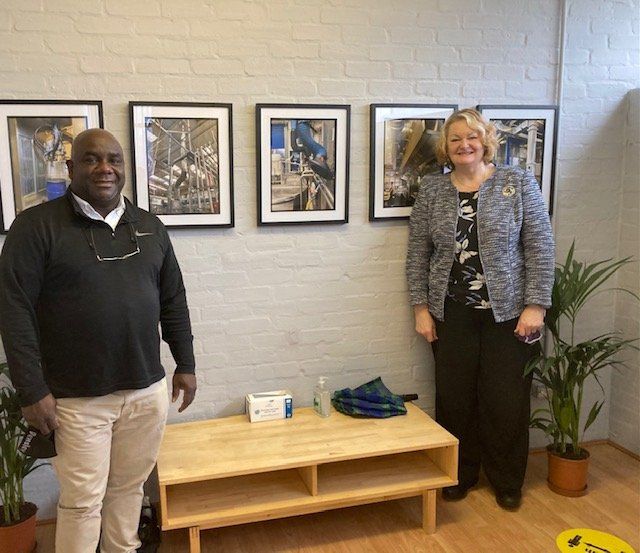CALL US 01294 203 374 | EMAIL
info@sigmaepd.com
Designed to Lead, Built to Last
Blog Layout
Five ways to avoid catching the virus indoors
Densley James • Aug 31, 2020
A Colleague of mine sent me this BBC news article. I wanted to share because at Sigma EPD we also believe that well designed ventilation is central to defending our family, friends, customers and employees from this and other pandemics and viruses year on year. Our defence is a Robust Ventilation Strategy (RVS) going forward. Please read below.
Covid-19: Five ways to avoid catching the virus indoors
By David Shukman
BBC News science editor
Good ventilation could be the key to avoiding coronavirus as autumn approaches and people spend more time indoors.
For months we've been told to wash our hands and maintain social distancing to beat coronavirus.
But scientists and engineers say we also need to think about the air we breathe, as children go back to school and more people return to offices.
Good ventilation matters in five ways.
1: If it's stuffy, walk away
When you walk into a room and the air feels stale, something is wrong with the ventilation.
Not enough fresh air is being introduced, which increases your chances of getting infected by coronavirus.
Recent research shows that in confined spaces there can be "airborne transmission" of the virus - with tiny virus particles lingering in the air. According to workplace regulations set up before the pandemic, everyone should get 10 litres of fresh air every second, and that matters more than ever now.
So if a place seems stuffy, just turn around and leave, says Dr Hywel Davies, technical director of the Chartered Institution of Building Services Engineers.
He says that it's vital to have a flow of clean air:
"If you've got someone who's infected in a building, and you're bringing in plenty of outside air, you're diluting whatever infectious material they're giving off. You're reducing the risk of other people becoming infected."
2: Look up at the air conditioning
From offices to shops, air conditioning is welcome on hot days - but check the type of unit.
The simplest is a slender white box mounted on walls or ceilings, known as a split air conditioner.
This draws in air from a room, chills it and then blows it back out again. In other words, it's recirculating the air.
This is no problem for a quick visit but may be a risk over a period of hours.
A study of a restaurant in China blamed this type of air conditioner for spreading the virus.
One customer was "pre-symptomatic" - in other words, he was infected but did not realise because he had yet to develop symptoms. Scientists reckon he released the virus as he breathed and talked, and it was pushed around the room by swirling air currents from the units on the wall.
The result was that nine other people became infected.
Dr Davies points again to the importance of fresh air: "If there had been a good supply of outside air, very likely fewer people would have become infected - if any."
3: Ask about the 'fresh air ratio'
In a modern building where the windows are sealed, how can you get enough fresh air?
You're relying on a ventilation system in which stale air is extracted from the rooms and piped to an air handling unit, often on the roof.
image caption A rooftop air conditioning unit
There, fresh air can be pulled in from outside and mixed with the old inside air, before being sent back into the building.
Given the risk of coronavirus infection, the professional advice is to maximise the fresh supply.
"Having 100% outside air or close to 100% is a good thing," says Prof Cath Noakes of the University of Leeds and chair of the environmental panel of the government's SAGE advisers, speaking in a personal capacity.
"The more fresh air, the less you're running the risk of recirculating the virus through the building."
The precise mix is decided by the building's managers, who may be working for the owners or the tenants. .
The drawback to running 100% fresh air is the cost - the incoming air has to be heated in winter and cooled in summer, all of which requires energy.
4: Check if there's virus in the filters
A modern ventilation system will have filters but these are not fool-proof.
In the US, researchers investigating the Oregon Health & Science University Hospital found that traces of coronavirus were trapped by the filters but some had somehow slipped through.
Prof Kevin van den Wymelenberg, who led the project, believes that swabbing the filters could reveal if there's someone infected working in a building.
In South Korea, a call centre on the 11th floor of an office building saw one person infect more than 90 others. If the filters had been checked more frequently, the presence of the virus might have been spotted sooner. Prof van den Wymelenberg says data from filters can "show us where to punch and when to punch" in tackling infections.
5: Watch out for draughts
Talk to any expert in the field and they will say that fresh air is the key.
But one specialist in modelling the movement of air says it's not that simple.
Nick Wirth used to design Formula 1 racing cars, and now advises supermarkets and food-processing companies on how to manage air flow to keep people safe.
He worries that if someone sitting beside an open window turns out to be infectious, they could shed virus to others downwind.
"If you open a window, where is the air going to go?" he asks. "We don't want people in a direct line of that airflow.
"More fresh air in general is better but if it's flowing horizontally and full of virus it could have unintended consequences."
I put this scenario to Prof Cath Noakes.
She says the benefits of plentiful fresh air diluting the virus will outweigh any risks.
An open window might lead to more people receiving the virus but in smaller, less risky amounts, in her view.
It's no surprise there are disagreements - there's a lot we still don't know about the virus.
But the air we breathe is bound to be part of any effort to make buildings safer.
See other Sigma post on our website blog (Sigmaepd.com)
Sigma Engineering Product Design

by Densley James
•
25 Oct, 2020
It is the simplest things in life that can have the biggest impact on the world’s greatest and most-baffling problems. But once discovered, their effectiveness and basic principles never change. In the case of the novel coronavirus, simple things like the washing of hands, the wearing of masks, and the application of the basic principles of ventilation, can capture and remove harmful substances from our breathing zone and can have an effective and lasting impact against COVID-19 and other viruses. We all hope that a vaccine will be found in the short term. However, current projections for a vaccine is the end of 2020, but in reality it may not become available for wide distribution and uptake until early to mid 2021. Further, there are questions around the rate of uptake, whether or not boosters would be required and how long immunity would last when vaccinated. The short and long response to these questions is that we do not have these answers. In reality we may not be able to eradicate this virus for some time. Some scientist estimate two years or longer. In the mean time we need to take a two-pronged approach: • Yes, we work in anticipation of a vaccine, wash our hands, keep our distance, and wear our masks. • But, we must also improve ventilation. We need to add "V" for ventilation to the governments acronym FACTS. Because, VFACT is that well designed ventilation would reduce the viral load in enclosed spaces, making it possible to reopen more safely and sustainably. Simple things first

by Densley James
•
24 Oct, 2020
The Guardian Saturday24 October 2020 Nicola Davis Science correspondent UK could be urged to keep windows open in effort to curb Covid-19 Scientists call for information campaign as evidence on role of poor ventilation mounts Britons could be urged to throw open the windows in an effort to keep coronavirus at bay as scientists call for a public information campaign to stress the importance of ventilation in reducing its spread. A paper by the Environmental and Modelling group for the government’s Scientific Advisory Group for Emergencies (Sage), dated 30 September, reveals concerns over the role of poor ventilation in the spread of the coronavirus, noting evidence that suggests insufficient airflow could increase the risk of transmission from tiny airborne particles known as aerosols that can carry the virus more than 2 metres. “Ventilation should be integral to the Covid-19 risk mitigation strategy for all multi-occupant public buildings and workplaces,” the team write. Prof Linda Bauld, an expert in public health at the University of Edinburgh, welcomed the emphasis on fresh air. “It is a really, really important topic that has not been given enough attention,” she said, noting that a number of outbreaks, including those involving choirs, have raised concerns over airborne transmission. The report urges the creation of a public information campaign on the issue. “A simple public guide on ventilation should be developed with reasons why ventilation is important, practical tips and/or FAQs,” the report notes, citing similar campaigns on the importance of handwashing and face coverings. Bauld noted that neither the UK messaging around “hands, face, space” nor the Scottish Facts campaign mention ventilation. But she added that information on ventilation would depend on the setting, meaning more complex messaging – a problem the report acknowledges. “Assessing ventilation in many environments requires engineering expertise, and mitigation measures are setting specific taking into account the nature of the building and users, ventilation type, length of exposure and activity,” the report notes.. Bauld added that in many settings, ventilation would involve a simple approach. “How are you going to get airflow in an enclosed indoor space? In most situation in the UK it is absolutely just about windows and doors,” she said. Dr Shaun Fitzgerald, from the University of Cambridge who contributed to the new report, said ventilation had been mentioned in government news meetings. But, he stressed, more needed to be done to highlight its importance, noting in his experience this was particularly necessary for smaller businesses such as convenience stores, independent coffee shops and hairdressers. “We need to raise the awareness, especially in colder weather where the natural inclination has been, for many places, which are possibly not well-designed, to close the windows and close the vents,” he said. According to the report: “Under steady state well-mixed conditions for the same duration, models suggest that exposure to aerosols approximately halves when the ventilation rate is doubled.” But while the report stresses the importance of ventilation, it says other factors must also be considered such as “thermal comfort”, exposure to pollution and energy use.
DESIGNED TO LEAD BUILT TO LAST
SIGMA Engineering Product Design Ltd
19 Macadam Place, South Newmoor Ind Est, Irvine KA11 4HP
Reg. No: 04475408
© 2024. The content on this website is owned by us and our licensors. Do not copy any content (including images) without our consent.











